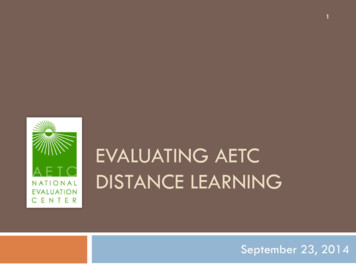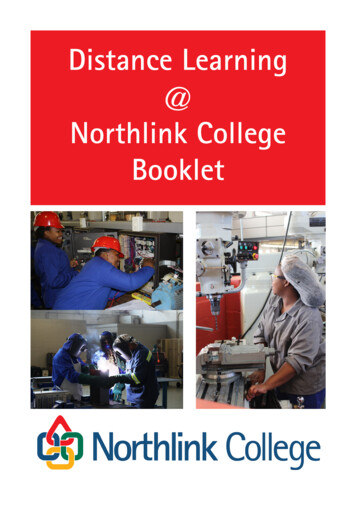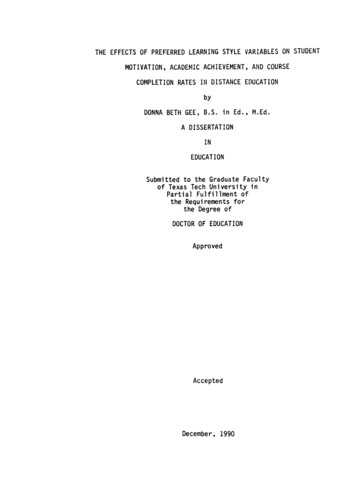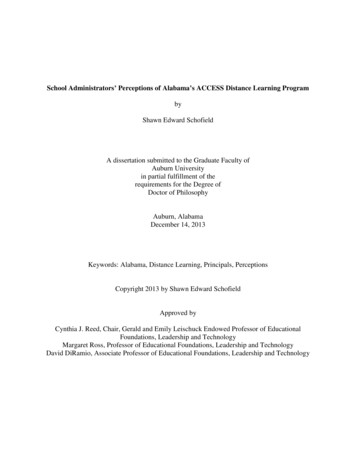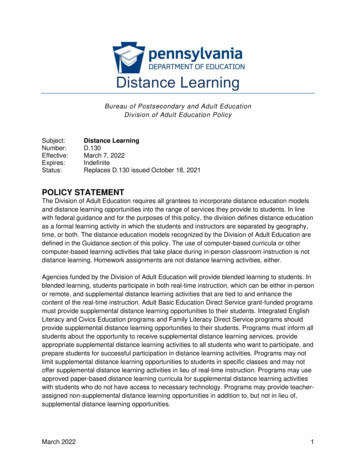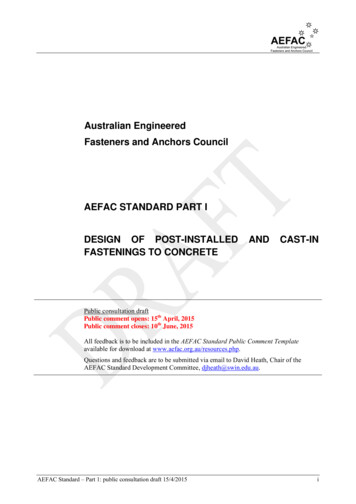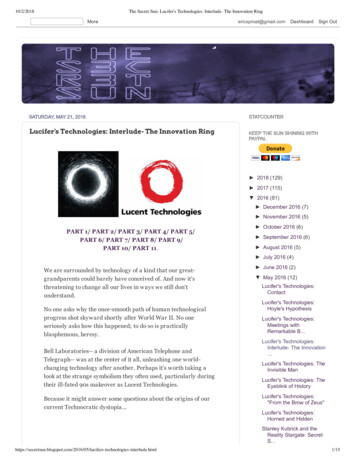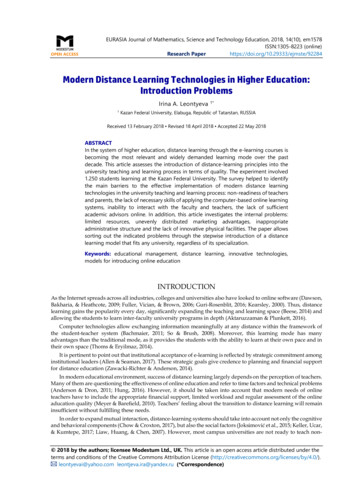
Transcription
OPEN ACCESSEURASIA Journal of Mathematics, Science and Technology Education, 2018, 14(10), em1578ISSN:1305-8223 (online)Research Paperhttps://doi.org/10.29333/ejmste/92284Modern Distance Learning Technologies in Higher Education:Introduction ProblemsIrina A. Leontyeva11*Kazan Federal University, Elabuga, Republic of Tatarstan, RUSSIAReceived 13 February 2018 Revised 18 April 2018 Accepted 22 May 2018ABSTRACTIn the system of higher education, distance learning through the e-learning courses isbecoming the most relevant and widely demanded learning mode over the pastdecade. This article assesses the introduction of distance-learning principles into theuniversity teaching and learning process in terms of quality. The experiment involved1.250 students learning at the Kazan Federal University. The survey helped to identifythe main barriers to the effective implementation of modern distance learningtechnologies in the university teaching and learning process: non-readiness of teachersand parents, the lack of necessary skills of applying the computer-based online learningsystems, inability to interact with the faculty and teachers, the lack of sufficientacademic advisors online. In addition, this article investigates the internal problems:limited resources, unevenly distributed marketing advantages, inappropriateadministrative structure and the lack of innovative physical facilities. The paper allowssorting out the indicated problems through the stepwise introduction of a distancelearning model that fits any university, regardless of its specialization.Keywords: educational management, distance learning, innovative technologies,models for introducing online educationINTRODUCTIONAs the Internet spreads across all industries, colleges and universities also have looked to online software (Dawson,Bakharia, & Heathcote, 2009; Fuller, Vician, & Brown, 2006; Guri-Rosenblit, 2016; Kearsley, 2000). Thus, distancelearning gains the popularity every day, significantly expanding the teaching and learning space (Beese, 2014) andallowing the students to learn inter-faculty university programs in depth (Aktaruzzaman & Plunkett, 2016).Computer technologies allow exchanging information meaningfully at any distance within the framework ofthe student-teacher system (Bachmaier, 2011; So & Brush, 2008). Moreover, this learning mode has manyadvantages than the traditional mode, as it provides the students with the ability to learn at their own pace and intheir own space (Thoms & Eryilmaz, 2014).It is pertinent to point out that institutional acceptance of e-learning is reflected by strategic commitment amonginstitutional leaders (Allen & Seaman, 2017). These strategic goals give credence to planning and financial supportfor distance education (Zawacki-Richter & Anderson, 2014).In modern educational environment, success of distance learning largely depends on the perception of teachers.Many of them are questioning the effectiveness of online education and refer to time factors and technical problems(Anderson & Dron, 2011; Hung, 2016). However, it should be taken into account that modern needs of onlineteachers have to include the appropriate financial support, limited workload and regular assessment of the onlineaducation quality (Meyer & Barefield, 2010). Teachers’ feeling about the transition to distance learning will remaininsufficient without fulfilling these needs.In order to expand mutual interaction, distance-learning systems should take into account not only the cognitiveand behavioral components (Chow & Croxton, 2017), but also the social factors (Joksimović et al., 2015; Keller, Ucar,& Kumtepe, 2017; Liaw, Huang, & Chen, 2007). However, most campus universities are not ready to teach non 2018 by the authors; licensee Modestum Ltd., UK. This article is an open access article distributed under theterms and conditions of the Creative Commons Attribution License tyevai@yahoo.com leontjeva.ira@yandex.ru (*Correspondence)
Leontyeva / Problem of Work with Distance Learning TechnologyContribution of this paper to the literature The paper provides the most optimal and universal model of online education, deigned to eliminate theidentified problems.The introduced system meets the principles of student-centered learning and helps to increase the studentand teacher’s interest in designing a comprehensive distance learning system. Table 1. Content of questionnaire Question1. Do you enjoy working in an online environment? Why?2. Describe the main advantages and disadvantages of distance learning.3. How do teachers of your University regard online education?4. What do you know about the e-learning courses offered in the University?5. What, in your opinion, are the main obstacles to full implementation of the distance learning principles in your University?traditional students on a massive scale from the perspective of institutional ethos, culture, structure andadministration (Xiao, 2018).One can note that despite the fact that discourse touching the distance education is popular, Russian e-learningmarket has many institutional barriers. Even in an academic environment, branding is crucial (Drori, 2015).Therefore, large universities will have a greater competitive advantage by positioning themselves as experts increating training materials of required quality. They will also be more competitive due to the economic benefits ofthe reached coverage. The capital universities are promoting their educational services in the regions more oftenby opening branches and representative offices. This forces regional universities to focus on more innovativelearning principles.Thus, the purpose of this research is to assess the quality of the e-learning system implementation. The researchwas conducted at Kazan Federal University to define barriers to efficient implementation of distance learningtechnologies and to introduce a new model, which will have a positive effect on the e-learning development in highschool.METHODCurrently, distance-learning courses are being actively designed by teachers of the Elabuga Institute of theKazan Federal University and are widely introduced into the teaching and learning process. Electronic learningcourses were designed through MOODLE LMS for Life Safety, Vertebrate Zoology, Structural Botany, Phytocenologyand Molecular biology on the KFU Distance Learning Site (Faculty of Natural & Mathematical Sciences) (KazanFederal University, 2018). Such courses are open and accessible for full-time bachelor (undergraduate) students ofvarious pedagogical directions and specialization.The quality of the e-learning system introduction into the university teaching and learning process will beassessed through the analysis of the experience in using e-learning courses for teaching bachelors, mostsignificantly the Pedagogical Education bachelors. The research involved 1250 students of age between 20 and 22from 12 departments of Kazan Federal University. There were 41.04% of male (513) and 58.96% of female students(737). The majority of participants were the third-year students – 894 (71, 52%).Since distance education is currently highly relevant, it is carried out in full scope in the Elabuga Institute. Everyuniversity teacher is designing e-learning resources that are widely applied with traditional modes (KFU DistanceLearning Site). The students subscribe for these courses without fail and are trained under strict regulation.Data were collected between November 2017 and January 2018. Written permissions from the respondents touse their personal data allowed us to conduct a survey and analyze its results. None refused to take part in thesurvey. The statistical error was 2%.At the first stage, testing was to determine the main problems and concerns of students about the onlinelearning. The questionnaire consisted of five questions.The questionnaire structure is presented in Table 1.Data were collected and then placed into a database to track and organize the information. The number ofrelevant forms after the survey was 1238. Quantitative data were interpreted using descriptive analysis.Based on questionnaire analysis and the study of the teaching and learning process quality, the main problemsof introducing the distance learning principles were identified. Our original system was designed to eliminate theidentified barriers.2/8
EURASIA J Math Sci and Tech EdModels for introducing distance learning into the learning process were built according to the CAPDMmethodology that helps universities and other learning providers to design and manage the world-class programsof online distance learning (CAPDM, 2007). Besides, it is based on the theory of distance learning introduced byMoore and Kearsley (2011).Thus, three blocks of distance learning have been tested. Learning approach was shaped according to P-3 Model– learning process included 8-week courses with eight learning modules (Anderson & Gualco, 2016). Theexperiment involved students handling the online curricular materials individually and under the guidance of ateacher. Learning tools were the email, content material, discussion forums, video conferencing solutions, onlinetests and the learning management system Moodle . The latter software is an open source project with no licensingcosts.University administration made structural changes to improve program quality and education service, and toensure program success. Thus, there was established a special subdivision responsible for orchestrating andmanaging the principles of distance learning. The subdivision has 2 representatives of university administrationand 2 students in staff for each faculty, who performed the university’s research and organizational activities athigh scores. There were allocated teachers responsible for the high-quality implementation of the introducedsystem in each separate structural unit of the university (n 24, two teachers for each faculty). Subdivision membershad regular meetings on the problem issues and options for future performance. Moreover, additional wirelesslaptops were made available to increase the access to computers for students.RESULTS AND DISCUSSIONA survey was to identify students’ attitudes toward distance learning. We have asked the students whetherthey like to learn using online courses and 90% of respondents answered positively, arguing that they can learn thesubject at any time (within the limits for learning the unit). It should be noted that distance learning requires thestudents to be highly independent, but the results showed that not all students were ready to work independently.Almost all the students (95.6%) have positively assessed the effectiveness of using distance e-courses. Theynoted that the advantage of such training is that there is a wide opportunity to learn the material and performassignments in any place and at any free time. Students noted a wide variety of assessment materials worked outin the electronic courses: tests and problems, creative assignments or case studies, group projects on-line, essays,interactive lectures, hyperlinks, group chat, forum. In addition, students noted that the electronic course is enrichedwith a large amount of reference information in the form of links to specific sites, electronic textbooks, videomaterials, etc. This aspect is very important for learning the course.As for the quality of distance learning, students have highlighted both its advantages and disadvantages: 85.14%of students noted the availability of distance learning as its advantage. One can learn any electronic courseanywhere with any electronic device with Internet access. As it turned out, the psychological aspect of learningwith a distance course is also important for a student. At this point, 57.01% of respondents experienced a decreasein anxiety when performing control tasks (for example, tests, credit-tests).Besides, recorded answers indicate that distance courses contribute to the development of independent activityskills. The student can independently define how many time he/she needs to go through the same module and/orcourse unit.The students have pointed out to the possibility of communicating not only with the teacher (student-teacherinteraction) during such courses, but also among themselves (student-student interaction) throughout the periodof learning the course.The main shortcomings of distance learning are the lack of full-fledged communication with teachers and fellowstudents (about 44% – 541 students), the lack of skills required for handling the computer-based online learningsystems (57.9% – 712 respondents) and the critical attitude of parents to such type of activity (39.7% – 488respondents). As for the positive aspects, almost all the participants have pointed out to an opportunity to expandtheir own space (89.7% – 1103) and save their free time (80.9% – 995 students).The analysis of answers has also revealed that the most common concerns regarding the distance education arethe concerns about the inability to interact with the faculty and teachers (55.3% – 680 students) and inability to seekhelp if it is needed (35.8% – 440 students). Thus, respondents also indicated the lack of sufficient academic advisorsonline (25.8% – 292 students). Less than one percent of respondents (3 persons) wrote that their academic groupsize is not appropriate for online learning.It is pertinent to point out that students with the highest level of confidence face significantly fewer obstacles tosocial interaction and various administrative issues while using online learning technologies.Despite the fact that students are well aware of online learning opportunities, only half of them (623 students –50.65%) were able to name the specific e-learning courses designed for areas that already run in the University.3/8
Leontyeva / Problem of Work with Distance Learning TechnologyAt the same time, 84.00% of respondents believe that the process of introducing distance learning into theteaching and learning process is just beginning in the higher educational institutions, while 16.00% note thatdistance-learning technologies are applied at a high level. This suggests that, currently, distance learning potentialhas not been fully realized to increase the competitiveness of universities. Many teachers still intent to implementthe traditional teaching mode, because they believe that it takes quite a lot of time to prepare this course. On theother hand, the lack of material compensation reduces the interest of teachers in using the problem-developingtasks. This, in turn, reduces the effectiveness of distance learning. The majority of teachers (78.06%) called for thecombination of distance with full-time modes.We have asked what electronic courses are taught at the university and the majority of students (79.6%) namedthose they had taken starting from the first year of learning at the university. Both compulsory and elective courseswere included in the list of electronic courses. At this point, 16.05% of respondents named courses that they did nottake, but learned about them from the university website; 3.09% of respondents found it difficult to answer.As soon as the obstacles of distance learning introduction were identified, the internal barriers should beanalyzes and assessed carefully. Therefore, the first internal problem that needs to be solved is an incorrectassessment of the university’s potential. As the strategic goals are set, university administration has to assess theopportunities, namely – to see how all types of distance learning contribute to the goal achievement. This meansthat the project is assessed on all items, including costs, financial and non-financial benefits, and the payback factor.Even if external factors are ignored, it is necessary to determine the market potential of the university, toestimate the sales of education services, to calculate the costs and to forecast the effectiveness throughout thedistance-learning project realization. In this regard, distance-learning principles can be introduced into theuniversity teaching and learning process in different ways.Based on the analysis of these models, we came to the conclusion that at this stage of modern educationdevelopment it is expedient to apply a mixed training model combining the elements of distance education withthe traditional learning process in different proportions. This model is widely applied in the higher educationalestablishments at the present stage of the social development. However, it looks like the full-time mode is going tobe replaced with the distance learning almost completely. Therefore, distance education should be supplementedby direct contacts with highly qualified teachers, who have related skills, as well as with practitioners, who havepractical experience in the specified field. Thus, let us consider the 3 proposed models (Figure 1).Thus, models 2 and 3 can be applied for radical changes in an educational establishment, while model 1, in fact,is an independent approach that will not completely contribute to changes, but will contribute to a quick andeconomically profitable entrance to a new market. This indicates that the educational establishment is a strategicobject for distance learning and a vision of what we want to achieve in this area of activity.It should be noted that one cannot ignore the distance learning introduction as the internal characteristics of theestablishment on the way of entry into this field of activity. The education market structure and competition arethe main factors contributing to the success/failure of the educational establishment, but not its internalcharacteristics and potential.Since distance learning is being improved and supported by technical innovations and infrastructure, it isnecessary to have a support staff and an established structural system for successful entrance to the distanceeducation market. In the higher educational establishments, technological infrastructure is usually not developedat a sufficiently high level, while the required internal skills are also low. Nevertheless, the establishment has toanalyze the possibilities, capacity and accessibility of the technological infrastructure before making a decision todesign a distance-learning program.All the elements of technological infrastructure, including the administrative support and the elements ofproduction cycle and learning material presentation, must correspond to the state standards. This infrastructure isof strategic importance, as teaching materials are being converted into high-quality distance learning data. Thereare two problem areas in this perspective: writing the learning materials in accordance with the standards and inthe appropriate form; converting the prepared material into a form that will allow the students to learn at any timeand take advantage of learnt material in any situation.Thus, unlike the full-time mode, distance learning allows realizing the potential of technological infrastructurein such a way that it would be possible to provide the most intense educational experience. For example, testquestions do not have to be expanded as educational material because of the on-line mode. Therefore, it is necessaryto create measures to update and maintain the technical resources in the operating mode. Besides, IT system indistance education is effective due to the availability of a backup system that is constantly monitored, mostsignificantly if students are learning in different time zones.One can note that teachers from different countries and universities use Moodle to place notes, videos and tryto give students an understanding of content and tasks of different learning subjects (Chavan & Pavri, 2004; Vargaset al., 2016).4/8
EURASIA J Math Sci and Tech EdFigure 1. Introduced models of learningThe P-3 Model we applied has already demonstrated the ability to provide the highest possible level ofinstruction to students. Thus, the number of students taking at least one online course has increased to 6.7 millionin USA in 2013 (Allen & Seaman, 2013). At this point, the Pew Research Center found that while 77% of Americancollege presidents reported that their institutions offered online courses, only 50% of them agreed that these courseswere at the same level as traditional classroom lessons (Parker, Lenhart, & Moore, 2011).5/8
Leontyeva / Problem of Work with Distance Learning TechnologyInstitutional acceptance of distance learning is important for multi-national and developing societies. Forexample, the waist majority of teaching materials in Kyrgyz Republic is in Russian language. High andunsustainable cost of printed materials is a problem for book supply (Nurakun Kyzy, Ismailova & Dündar, 2018).Our research findings are in line with the studies conducted in Iran and Taiwan (Cheng, 2012; Mohammadi, 2015).Distance education develops through the targets set to improve the power, speed, and accessibility ofinstructional technologies (Conde et al., 2014; Shannon & Rice, 2017). Unfortunately, computer literacy remainsquite low among students for full-fledged systems application (Hatlevik, Throndsen, Loi, & Gudmundsdottir, 2018;Hoffman & Vance, 2005).Legitimate distance education continues to be the fastest growth area within high education (Reese, 2015).However, there are still some institutional and financial obstacles to holistic implementation of a distance learningframework, such as shortage of skilled teachers (Baran, Correia & Thompson, 2011) and the lack of technicalequipment (Rogerson-Revell, 2015) and poor government support (Piña, 2010).CONCLUSIONSTo sum up, distance learning has great potential to set a high standard for valuable learning experiences invirtual environments. The research involved 1.250 second-third-year students. The experiment has revealed thatstudents hold out for online learning, but there are concerns about the quality of interaction with teachers and theundeveloped technological infrastructure of the university. Thus, we have identified internal and external factorsthat hold back the implementation of modern distance learning technologies, such as limited scope and range ofimplementation; the problem of resources control; incorrect evaluation of marketing advantages; limited resources,inappropriate administrative structure, etc. The prospects for further research are centered on the assessment ofstudents’ knowledge and abilities during the next six months after the introduction of our program.ACKNOWLEDGEMENTSThe work is performed according to the Russian Government Program of Competitive Growth of Kazan FederalUniversity (MSRN: 1021602841391).REFERENCESAktaruzzaman, M., & Plunkett, M. (2016). An Innovative Approach toward a Comprehensive Distance EducationFramework for a Developing Country. American Journal of Distance Education, 30(4), 098Allen, I. E., & Seaman, J. (2013). Changing course: Ten years of tracking online education in the United States. SloanConsortium. PO Box 1238, Newburyport, MA 01950.Allen, I. E., & Seaman, J. (2017). Digital Compass Learning: Distance Education Enrollment Report 2017. BabsonSurvey Research Group.Anderson, N. B., & Gualco, D. (2016). Design of Distance Learning Systems Using a P-3 Model: Purposeful,Participatory and Project-Based. In EdMedia: World Conference on Educational Media and Technology (pp. 493497). Association for the Advancement of Computing in Education (AACE).Anderson, T., & Dron, J. (2011). Three generations of distance education pedagogy. The International Review ofResearch in Open and Distributed Learning, 12(3), 80-97. , R. (2011). Fortbildung Online. Entwicklung, Erprobung und Evaluation eines tutoriell betreuten OnlineSelbstlernangebots für Lehrkräfte (Doctoral dissertation).Baran, E., Correia, A. P., & Thompson, A. (2011). Transforming online teaching practice: Critical analysis of theliterature on the roles and competencies of online teachers. Distance Education, 32(3), 93Beese, J. (2014). Expanding learning opportunities for high school students with distance learning. American Journalof Distance Education, 28(4), 292-306. https://doi.org/10.1080/08923647.2014.959343CAPDM. (2007). An introduction to distance learning: Universities, colleges and distance learning: objectives, strategies andsurmounting the barriers, A paper for tertiary education providers. Retrieved on 21 January 2018 Chavan, A., & Pavri, S. (2004). Open-source learning management with Moodle. Linux Journal, 2004(128), 2.Cheng, Y. M. (2012). Effects of quality antecedents on e-learning acceptance. Internet Research, 22(3), 96/8
EURASIA J Math Sci and Tech EdChow, A. S., & Croxton, R. A. (2017). Designing a Responsive e-Learning Infrastructure: Systemic Change in .1262733Conde, M. Á., García-Peñalvo, F. J., Rodríguez-Conde, M. J., Alier, M., Casany, M. J., & Piguillem, J. (2014). Anevolving Learning Management System for new educational environments using 2.0 tools. InteractiveLearning Environments, 22(2), 188-204. , S. P., Bakharia, A., & Heathcote, E. (2009). Social networks adapting pedagogical practice: SNAPP.Drori, G. (2015). Branding universities: Trends and strategies. International Higher Education, (71), , R. M., Vician, C., & Brown, S. A (2006). E-learning and individual characteristics: the role of computer anxietyand communication apprehension. The Journal of Computer Information Systems, 46(4), 103-15.Guri-Rosenblit, S. (2016). Distance higher education in the digital era: Challenges and prospects. Distance Educationin China, 6, 16–25.Hatlevik, O. E., Throndsen, I., Loi, M., & Gudmundsdottir, G. B. (2018). Students’ ICT self-efficacy and computerand information literacy: Determinants and relationships. Computers & Education, 118, 011Hoffman, M. E., & Vance, D. R. (2005, February). Computer literacy: what students know and from whom theylearned it. In ACM SIGCSE Bulletin, 37(1), 356-360.Hung, M. L. (2016). Teacher readiness for online learning: Scale development and teacher perceptions. Computers& Education, 94, 120-133. mović, S., Gašević, D., Loughin, T. M., Kovanović, V., & Hatala, M. (2015). Learning at distance: Effects mpedu.2015.07.002Kazan Federal University. (2018). The site of distance education of Kazan Federal University. Retrieved on 20 March2018 from http://edu.kpfu.ru/Kearsley, G. (2000). Online education: Learning and teaching in cyberspace. Wadsworth Publishing Company.Keller, J. M., Ucar, H., & Kumtepe, A. T. (2017). Culture and Motivation in Globalized Open and Distance LearningSpaces. Supporting Multiculturalism in Open and Distance Learning Spaces, 146.Liaw, S., Huang, H., & Chen, G. (2007). Surveying instructor and learner attitudes. Computers & Education, 49(1),1066–1080. , J. D., & Barefield, A. C. (2010). Infrastructure and administrative support for online programs. Online Journalof Distance Learning Administration, 13(3), n3.Mohammadi, H. (2015). Investigating users’ perspectives on e-learning: An integration of TAM and IS successmodel. Computers in Human Behavior, 45, 359–374. https://doi.org/10.1016/j.chb.2014.07.044Moore, M. G., & Kearsley, G. (2011). Distance education: A systems view of online learning. Cengage Learning.Nurakun Kyzy, Z., Ismailova, R., & Dündar, H. (2018). Learning management system implementation: a case 1427115Parker, K., Lenhart, A., & Moore, K. (2011). The digital revolution and higher education: College presidents, public differon value of online learning. Washington, D.C.: Pew Research Center.Piña, A. A. (2010). Online diploma mills: Implications for legitimate distance education. Distance Education, 31(1),121-126. https://doi.org/10.1080/01587911003725063Reese, S. A. (2015). Online learning environments in higher education: Connectivism vs. dissociation. Education andinformation technologies, 20(3), 579-588. Revell, P. (2015). Constructively aligning technologies with learning and assessment in a 9.2015.1019972Shannon, L. J. Y., & Rice, M. (2017). Scoring the Open Source Learning Management Systems. International Journalof Information and Education Technology, 7(6), 432-436.So, H. J., & Brush, T. A. (2008). Student perceptions of collaborative learning, social presence and satisfaction in ablended learning environment: Relationships and critical factors. Computers & education, 51(1), 0097/8
Leontyeva / Problem of Work with Distance Learning TechnologyThoms, B., & Eryilmaz, E. (2014). How media choice affects learner interactions in distance learning classes.Computers & Education, 75, 112-126. s, Y. H., Solís, I. I., Espinosa, J. C. M., & Olivares, F. M. (2016). Distance Learning vs on Site Learning .20160603.01Xiao, J. (2018). On the margins or
of online distance learning (CAPDM, 2007). Besides, it is based on the theory of distance learning introduced by Moore and Kearsley (2011). Thus, three blocks of distance learning have been tested. Learning approach was shaped according to P -3 Model - learning process included 8-week courses with eight learning modules (Anderson & Gualco, 2016).

